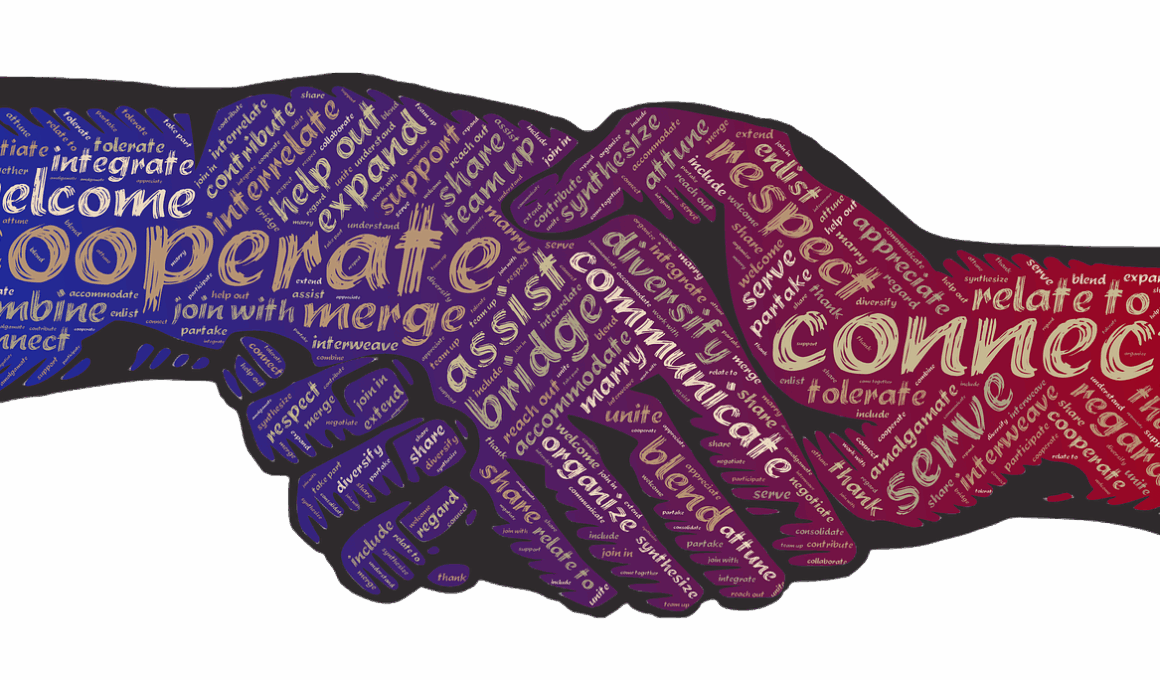Conflict Resolution Techniques for Cultural Disputes Post-Merger
Mergers and acquisitions often present significant cultural integration challenges. When two distinct organizations come together, cultural differences can lead to conflicts and misunderstandings. Addressing these issues is essential for a successful merger. One of the primary techniques in conflict resolution is open communication. This involves providing a safe space where employees can express their concerns and share their cultural perspectives. By fostering an environment of dialogue, organizations can reduce tension and misunderstandings. Another crucial approach is active listening, which entails genuinely considering the viewpoints of all parties. This process ensures that everyone feels heard, valued, and understood, promoting a collaborative atmosphere. Additionally, organizations can offer cultural awareness training, which provides employees with insights into the cultures they will encounter in the new environment. Training helps mitigate biases and preconceived notions, ultimately leading to smoother integration. Conflict resolution techniques not only help in resolving disputes but also in building trust among employees. The successful implementation of these techniques can significantly influence the overall performance and culture of the newly formed organization.
Cultural integration during mergers is fraught with challenges that can create conflict. Differences in communication styles, work ethic, and organizational values often surface, causing friction between teams. Conflict can arise from misunderstandings, misinterpretations, or even pre-existing biases. Therefore, cultivating cultural intelligence is vital for employees, as it allows individuals to navigate these differences effectively. Developing cultural intelligence can be achieved through training programs that emphasize understanding diverse cultural backgrounds, values, and communication styles. Moreover, mediation is an effective method for addressing conflicts. Having a neutral third party facilitate conversations between conflicting parties can help clarify issues and find common ground. This ensures that discussions are more constructive rather than confrontational. Furthermore, establishing shared goals can unify teams. Employees must recognize common objectives that align with the organization’s vision. Highlighting collaborative projects can help bond individuals from differing backgrounds and counteract negative feelings stemming from cultural disputes. Additionally, involving leaders in promoting cultural integration is crucial. When leaders demonstrate commitment to embracing diversity, it sets a precedent for all employees. Ultimately, these techniques enable organizations to transform cultural conflicts into opportunities for growth.
Fostering a Cooperative Environment
Creating a cooperative atmosphere is essential for conflict resolution in culturally diverse environments. Effective strategies include team-building exercises that promote bonding and understanding among employees. These activities allow team members from various cultural backgrounds to interact informally, facilitating personal connections. Additionally, encouraging collaboration on projects can be beneficial. By working towards common goals, employees can develop mutual respect and understanding, lessening the likelihood of future conflicts. Implementing a conflict resolution policy is also critical. A clear procedure enables employees to address grievances promptly and fairly, ensuring that issues are managed instead of allowed to fester. Encouraging inclusive practices further nurtures a cooperative environment. Organizations should continuously invite feedback regarding workplace culture and actively engage employees in discussions around cultural integration efforts. Furthermore, recognizing and celebrating cultural diversity within the workplace can strengthen relationships. Special events or acknowledgments of various cultural traditions can foster appreciation and understanding. Engaging in community service as a united team can also enhance cooperation, drawing attention away from differences. Ultimately, fostering such an environment reduces tension and conflict, allowing organizations to thrive in their newly integrated cultural landscape.
Effective conflict resolution requires ongoing commitment to understanding and integration. Organizations must regularly evaluate their progress in cultural integration and be willing to adapt their strategies. Conducting surveys or feedback sessions can be instrumental in identifying areas of improvement and recognizing potential sources of conflict. Furthermore, providing resources for employees such as counseling services can be beneficial. Access to professional guidance allows employees to work through personal challenges, alleviating some pressures related to the cultural shifts experienced in the workplace. Additionally, mentorship programs can play a pivotal role in guiding individuals through the complexities of the new cultural dynamics. Pairing seasoned employees with newcomers fosters understanding and knowledge sharing, enhancing the overall integration process. Training programs that address conflict resolution tactics specifically tailored to cultural disputes can also be effective. When participants understand various methods for managing conflicts, they are better prepared to handle situations that may arise. Finally, organizations should prioritize inclusivity in their policies and procedures. By embedding cultural sensitivity within their core practices, companies can create an ecosystem wherein employees feel valued and respected regardless of their backgrounds, reducing potential conflicts.
The Role of Leadership in Cultural Integration
Leadership plays a pivotal role in the success of cultural integration post-merger. Leaders set the tone for organizational culture and influence employee behavior significantly. As such, they must actively engage in promoting positive cultural exchange. One effective method is for leaders to model inclusive behavior by showing respect for differing perspectives. Leaders should also communicate the importance of cultural integration openly, reiterating its value to the organization’s success. Furthermore, leaders must invest in their teams by providing training and resources that enable individuals to embrace diversity. Regular check-ins and open forums allow leaders to gauge employee sentiments and address concerns promptly. Supporting employee resource groups can also foster a sense of belonging among diverse teams. Encouraging these groups to form and supporting their initiatives shows that leadership is committed to inclusivity. Additionally, leaders must celebrate achievements related to cultural integration, whether big or small. Recognizing collaborative efforts strengthens team dynamics and reinforces the significance of cultural understanding. As a result, when leaders take an active stance in addressing cultural disputes, they create an environment conducive to resolving conflicts and advancing mutual respect among employees.
Ongoing evaluation and feedback mechanisms are essential for enhancing cultural integration during mergers. Employing regular assessments allows organizations to track their cultural integration endeavors effectively. Feedback can range from informal discussions to structured surveys, providing valuable insights into employee sentiments. Management must be receptive to criticism and open to making necessary adjustments based on employee feedback. Additionally, creating a safe environment to express concerns mitigates the chances of conflict escalating. Organizations can conduct regular meetings focused specifically on cultural issues and resolutions. These discussions not only provide clarity but also demonstrate organizational commitment to addressing concerns. Moreover, integrating technology into the feedback mechanism can streamline communication. Platforms for anonymous feedback can be highly effective in ensuring that all voices are heard. Additionally, celebrating diversity should be an integral part of the evaluation process. Acknowledging cultural contributions strengthens the organization’s commitment to inclusivity. Overall, by fostering an environment of continuous improvement, companies can effectively navigate cultural disputes and enhance productivity across all teams. This approach will ultimately lead to a more harmonious workplace, even in the face of challenging cultural integration scenarios.
Conclusion: Embracing Cultural Diversity
In conclusion, effectively managing conflicts arising from cultural integration challenges during mergers requires a multifaceted approach. Employing strategies like open communication, active listening, and cultural training builds a foundation for successful integration. Leaders play a crucial role in modeling inclusive behavior, encouraging collaboration, and supporting resource groups. Cultivating a cooperative environment, acknowledging feedback, and celebrating diversity are equally vital for fostering unity among employees. By implementing these conflict resolution techniques, organizations can transform potential cultural disputes into opportunities for learning and growth. Establishing clear guidelines and ongoing assessments for resolution processes further fortifies the organization against future conflicts. Ultimately, embracing cultural diversity yields numerous benefits, such as enriched creativity and enhanced team performance, providing a significant competitive edge in today’s global business landscape. Therefore, organizations should strive to develop a robust framework aimed at integrating cultures post-merger. Prioritizing cultural understanding can position organizations to thrive amid challenges, ensuring a resilient and adaptable workforce. By doing so, companies not only foster a harmonious workplace but also unlock the full potential of their diverse talent pool, leading to sustained success in their post-merger journey.
This closing paragraph encapsulates the importance of conflict resolution techniques in ensuring a smooth transition during mergers. Organizations that strategically manage cultural integration not only minimize conflicts but also foster better collaboration among employees. Awareness of cultural differences creates an inclusive environment and drives positive outcomes. Furthermore, integrating new cultures requires ongoing commitment, listening to employee feedback, and embedding diversity into company values. This comprehensive approach can lead to healthier organizational culture and higher employee satisfaction. Ultimately, the key lies in seeing cultural diversity as an asset rather than a challenge, enabling businesses to innovate and grow. By valuing collaboration, organizations can enhance their overall performance. Thus, applying these strategies ensures that cultural integration is not merely a process but a path to organizational excellence.


